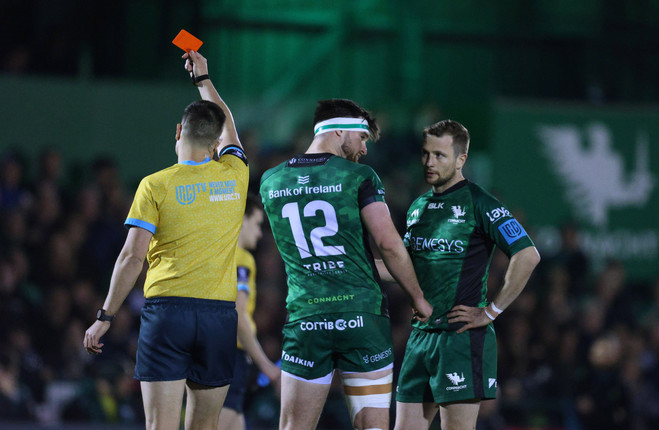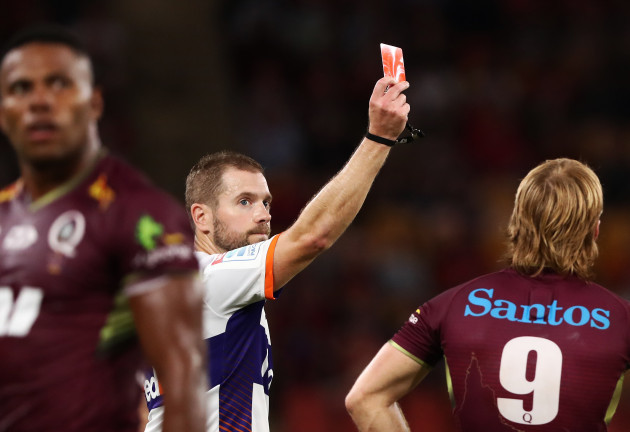THE URC’S HEAD of match officials has admitted that there remains too much inconsistency in how dangerous high tackles and clearouts are being penalised by referees.
The sanctioning of collisions involving head contact is an extremely hot topic in rugby at present.
Tappe Henning, who joined the URC in December, believes that some match officials are attempting to find mitigation where it may not exist, allowing them to reduce the sanction against offending players, while other match officials are not stringently applying mitigation where it does exist.
Next week, a joint URC and EPCR match officials workshop will take place in order to re-focus on this area ahead of the play-offs in the Champions Cup and the URC, with Henning stressing the need for consistency.
Despite a recent spate of red cards and citings for high tackles, Henning said he believes that players are actually adapting their behaviour on the pitch.
“There is an improvement, the players are much more aware,” said Henning yesterday.
“We’re seeing the power of decision-making by the defenders, that’s getting better. They’ve got the power of decision-making, how they’re going to go into a tackle, and that’s what we’ve targeted to change – that they make better decisions as they move into a tackle.
“We’re seeing a lot less head contact that’s from reckless and careless charging into a tackle, but more an effort to get the head and arms in the right place to make sure the head is in the right place to enter a tackle.
“We are still a bit concerned that there’s a lot of inconsistency in how it’s being dealt and the mitigation process of it. We’re working very hard on that and we’re having an EPCR and URC workshop next week over two nights to discuss this specifically before we go into our play-off stages so we can align ourselves a bit better, so there’s a clear message to match officials, teams, and players on the expectations.
“We have got to the point where we had to address that but, yes, we can see there is an effort from teams and players on their decision-making entering tackles or clearouts to make sure there’s not two heads in the same space.”
Asked if he feels match officials are using mitigation too often, Henning indicated that it works both ways.
“We’re trying to get a better balance,” he said.
“On some occasions, the mitigation is being looked for, they’re looking for stuff. And we would like the mitigation to show itself, they shouldn’t chase a mitigation in a decision. It must be clear and obvious, so we’re pulling it a little bit back.
“And then there are some occasions where there is mitigation that is not mentioned or picked up on. So it’s a bit of a mixed bag at the moment.
“Our aim in this workshop will be to align EPCR and URC with play-off games around the corner, getting a better understanding with match officials, teams, coaches and players on what to expect.”
The 20-minute red card trial currently being used in Super Rugby Pacific in the Southern Hemisphere remains very divisive.
This trial means that when a player is shown a red card, he leaves the field permanently but can be replaced by a different player 20 minutes later.
World Rugby has recently indicated that it would need further trials to take place before concluding whether the 20-minute red card is effective.
When asked if the URC will consider implementing this law trial, Henning expressed reservations.
“We need to look into that,” said Henning. “My understanding is that there is a lot of information being collected at the moment to see the impact it has had.
“The other side of the coin is that we have to protect the integrity of the 80 minutes of rugby and the enjoyment of somebody who paid to watch 15 against 15 that’s spoiled after two minutes because a red card has been given.
“As a contest between two teams that are pretty much equal in ability, it appears that at some stage that contest gets influenced by 14 against 15, be it in the last 10 or 15 minutes like in the England game.
“The other side of it is that if you want to change player behaviour around head shots and things, the punishment must fit the crime. How do you change behaviour with soft decisions? There must be a tangible consequence for players to realise, ‘I’ve got to take more care about how I handle myself on the pitch and how I handle my opponents because it could cost my time dearly, so I need to make some changes to my behaviour on the pitch.’
“If the punishment does not fit the crime, it’s not going to change the behaviour. That’s the situation we find ourselves in. We will continue to investigate but I believe we will get to an appropriate solution to protect our 80 or 90 minutes of rugby with 15 against 15. Once we’ve got a lot of information on the table, it will be an informed decision about whether it’s going to be 20 minutes, 15 minutes, what’s the consequence going to be.
“But we still need to do a lot of research before we go into a 20-minute red card and then it’s 15 on 15 again. We need to come up with the best outcome and not just after two years, decide it’s not working and then change again.
“I’m a big supporter that we need to protect 15 against 15 in some form of decision about red cards.”



